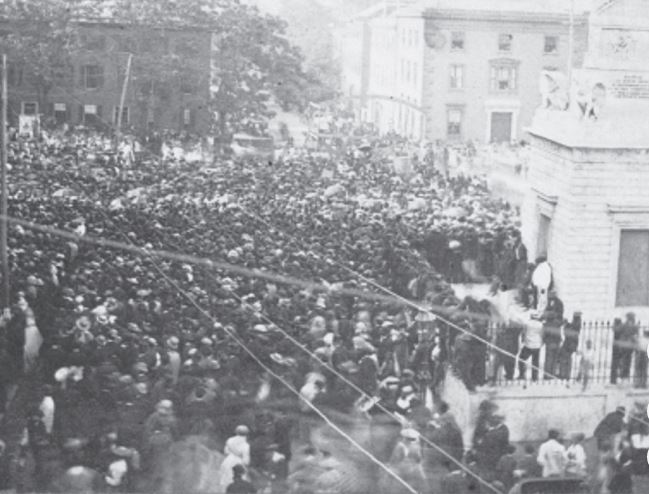[ad_1]

By Sean Yoes
AFRO Baltimore Editor
[email protected]
On May 19, 1870, more than 10,000 Black men, women and children marched through the streets of Baltimore to celebrate the ratification of the 15th Amendment, the largest celebration of Black men receiving the right to vote in the country. And it was the great abolitionist and statesman Frederick Douglass, who returned to his childhood hometown and delivered perhaps the most stirring speech of that momentous day.
“The colored citizens of Baltimore yesterday celebrated in an imposing and hearty manner the ratification of the fifteenth amendment to the constitution of the United States, under which they acquire the same right of suffrage as is possessed by white citizens,” reported the Baltimore Sun in its exhaustive coverage of just about every facet of the colossal event. “The day was one of the brightest of the season, and the entire colored population seemed to have come forth upon the streets and entered into the spirit of the occasion, those not taking part in the grand procession, which was the chief feature, occupying positions on the sidewalks, where the women and children particularly stood in masses for many hours. Large numbers of the white population also were upon the principal streets through which the anticipated pageant was to pass, occupying doors, windows, etc., in order to get a good view of it.”

What they all witnessed on, “The Great Jubilee Thursday,” as it was called by many was perhaps the most prodigious public display of Black pride and Black power to that date in American history. Just five years after the Emancipation Proclamation, it was the largest demonstration ever held in the country by Black Americans.
The original parade began in East Baltimore on Broadway, went West into Downtown, North on Charles into Mt. Vernon, and to Orchard St., South on Eutaw St., down to Camden Yards, back up to Baltimore St., and ended at the Battle Monument at Fayette and Calvert.
The parade included groups representing: fraternal orders, occupational organizations, politics, sports, music and the military. The ubiquitous participation of the occupational and military organizations in particular may have been the greatest affront to the fallacy of White supremacy. Several of the occupational organizations represented Black excellence and dominance in those industries. For example, the Colored Caulkers Trade Union Society represented the Black men that dominated the ship caulking industry. Fells Point was a major center for ship caulking in the 19th century, and the Colored Caulkers Trade Union Society specifically was a cooperative that owned a shipyard and railroad.
About a dozen Black military groups including: the Lincoln Zouaves, the Oakmen Invincibles, the Grand Army of the Republic, 19th Ward Lincoln Rangers, the 9th Ward Invincibles, the United Sons of Gideon and the Bond Loyal Guards, marched through the streets of Baltimore, some on horseback, most of them brandishing weapons. The message transmitted was inescapable; Black people fought and died for the franchise and they were prepared to protect it with their lives.
At the end of the glorious parade, speakers gave powerful oratories to not only celebrate this definitive chapter in the Black American experience, but to inspire those gathered to press onward in the midst of a country hostile to their very existence.
Some of the more prominent speakers included: Issac Myers, who was president of the Chesapeake Marine Railway and Dry Dock Company, and served as the parade’s president; John Mercer Langston, the first Black to hold federal elected office in the U.S. and John Stella Martin, the pastor and abolitionist (his mother was a Black slave, his father a White slave owner), who escaped slavery and was selected to represent the American Missionary Association in England.
But, none of the speakers was more formidable on that day than Maryland’s native son Frederick Douglass, the abolitionist and national Black leader, who once lived in Fells Point as a young slave.
“…But, the time has come when the Blackman owes nothing to the States. You are not indebted to Maryland for the franchise. The old ideas of State sovereignty have been abolished by the war. We have now a common country and a common legislature, there are no States but the United States,” proclaimed Douglass. “All that any man can ask of another is that he do his best for the whole country. Will you be as good masters to yourselves as your masters were to you? (the crowd responded with cries of “better!”) Will you work as hard for yourselves as you did for your masters? ( the crowd responded with cries of “yes!”) Will you be as sober and temperate now as you were before? (renewed cries of “yes!”) I believe you but some affect not to,” he added.
“They believe that you will die out like the Indian, that you cannot exist in competition with the White men. Well, if two centuries and a half of slavery, the whip, prisons, and the abolition of marriage relation could not kill you then liberty will not. (applause) Educate your sons and daughters, send them to school and show that besides the cartridge box, the ballot box, and the jury box, you have also the knowledge box. Build on for those who come after you.”
Special thanks to Prof. Larry S. Gibson, of the University of Maryland Law School, perhaps the foremost authority on Thurgood Marshall and Maryland’s Black Lawyers, for providing photographic and historical support for this story. Gibson is organizing a massive re-enactment of the 1870 celebration in commemoration of the 150th anniversary, on May 17. If you would like to participate in the re-enactment, email Gibson at: [email protected], with the subject: “15th Amendment.”
[ad_2]
Source link
